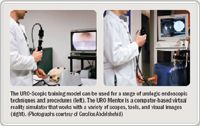Article
Ureteroscopy trainers show similar effectiveness
Amsterdam, Netherlands--A model-based training format and an interactive virtual reality simulator trainer that were developed to teach basic ureteroscopy skills showed no significant points of difference when compared in use by inexperienced medical students, reported researchers from the University of California, Irvine.
Amsterdam, Netherlands-A model-based training format and an interactive virtual reality simulator trainer that were developed to teach basic ureteroscopy skills showed no significant points of difference when compared in use by inexperienced medical students, reported researchers from the University of California, Irvine.
A study comparing the two training modalities revealed that five students from both groups scored over 80%, and only one student from each group scored below 50% on a quality assessment evaluation of their ureteroscopy performance, according to co-author Corollos Abdelshehid, a junior specialist in the UC Irvine department of urology working with Elspeth McDougall, MD, and colleagues.

The investigators tested the students 2 months after the ureteroscopy training session on a porcine model kidney/ureter. They noted the students' independent performance of ureteroscopy, including safe removal, laser lithotripsy, and basket extraction of a mid-ureteral calculus using guidewire access, and their ability to identify a ureteral stone.
Low failure rate
An expert surgeon evaluated each study participant and scored them on the completion of six specific steps involved in the procedure, as well as on the quality of their performance in handling the issues and equipment, for a possible score of 35 points. He also evaluated participants for their efficiency, knowledge of instruments, operation flow, use of assistants, and knowledge of the specific procedure.
All students in both training groups were able to complete all six steps of the procedure correctly 2 months after the training session, regardless of the training modality they used to learn. The group using the ureteroscopy training model scored a mean 23.6±5.4 points (range: 16 to 31 points), and the virtual reality simulator group scored a mean 22.9±4.8 points (range: 16 to 30 points) (p=.38) for their qualitative assessment.
No individual participant scored a quality assessment score in excess of 90%. However, three members of the virtual reality simulator group and two members of the ureteroscopy training model group achieved quality assessment scores of 80% or higher. Only one participant in each group scored less than 50% on the qualitative assessment of the ureteroscopy procedure. A qualitative assessment score below 70% was observed in four participants who trained in the ureteroscopy training model group and in five participants who trained in the virtual reality simulator group.
The investigators noted no statistical difference between the two groups in their ability to perform the basic ureteroscopy procedure in the animal model following either training format.
"A virtual reality URS simulator and a materials URS training model are equally effective in providing basic URS training to inexperienced trainees," said first author David S. Chou, MD, a clinical instructor in urology at UC Irvine when the study was conducted. "It is vital to have dedicated teaching by an expert surgeon for the initial success of the educational process."
Dr. Chou explained that both model-based and virtual reality simulation were gaining interest as alternative surgical training methods. Despite their cost, the incorporation of these models and simulators into urologic training programs is important to determine their effectiveness as educational tools and their ultimate value in teaching urologic procedures, he said.
Dr. McDougall has received grant support from Astellas Pharma US, Inc. as the director of the Astellas Center for Urological Education at UC Irvine. She also has received equipment and/or instrument support for this center from Storz Endoscopy, Intuitive Surgical, Simbionix, Ethicon Endo-Surgery, Inc., and an unrestricted grant for urologic research from Endocare, Inc.















